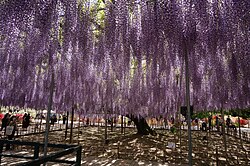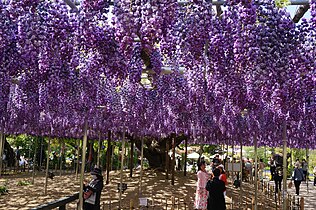bio.wikisort.org - Plant
Wisteria floribunda, common name Japanese wisteria (藤, fuji), is a species of flowering plant in the family Fabaceae, native to Japan.[1] Growing to 9 m (30 ft), it is a woody, deciduous twining climber. It was first brought from Japan to the United States in the 1830s.[2][3] Since then, it has become one of the most highly romanticized flowering garden plants. It is also a common subject for bonsai, along with Wisteria sinensis (Chinese wisteria).
| Wisteria floribunda | |
|---|---|
 | |
| Longwood Gardens, Pennsylvania | |
| Scientific classification | |
| Kingdom: | Plantae |
| Clade: | Tracheophytes |
| Clade: | Angiosperms |
| Clade: | Eudicots |
| Clade: | Rosids |
| Order: | Fabales |
| Family: | Fabaceae |
| Subfamily: | Faboideae |
| Tribe: | Millettieae |
| Genus: | Wisteria |
| Species: | W. floribunda |
| Binomial name | |
| Wisteria floribunda (Willd.) DC. | |
The flowering habit of Japanese wisteria is perhaps the most spectacular of the Wisteria genus. It sports the longest flower racemes of any wisteria; Some of those cultivars can reach 2 m (7 ft) in length.[4][5] These racemes burst into great trails of clustered white, pink, violet, or blue flowers in early- to mid-spring. The flowers carry a distinctive fragrance similar to that of grapes. The early flowering time of Japanese wisteria can cause problems in temperate climates, where early frosts can destroy the coming years' flowers. It will also flower only after passing from juvenile to adult stage, a transition that may take many years just like its cousin Chinese wisteria.
Japanese wisteria can grow over 30 metres (98 ft) long over many supports via powerful clockwise-twining stems. The foliage consists of shiny, dark-green, pinnately compound leaves 10–30 centimetres (3.9–11.8 in) in length. The leaves bear 9-13 oblong leaflets that are each 2–6 centimetres (0.79–2.36 in) long. It also bears numerous poisonous, brown, velvety, bean-like seed pods 5–10 centimetres (2.0–3.9 in) long that mature in summer and persist until winter. Japanese wisteria prefers moist soils and full sun in USDA plant hardiness zones 5-9.[6] The plant often lives over 50 years.
Cultivars
Those marked agm have gained the Royal Horticultural Society's Award of Garden Merit.
- 'Burford' agm[7] — pale violet with purple keel
- 'Domino' agm[8] - pale lilac
- 'Hon-beni' or 'Rosea' agm[9] - pale rose flowers tipped purple, 18 in (46 cm) long
- 'Issai Perfect' - light lavender flowers
- 'Ito Koku Riu' or 'Royal Purple' - dark blue or violet flowers, lightly scented, long clustered bunches, 30–50 cm (12–20 in) long
- 'Jako' or 'Ivory Tower'
- 'Kimono' agm[10]
- 'Kokuryu' agm[11] - violet, scented
- 'Kuchibeni' or 'Carnea' - pink flower
- 'Lawrence' agm[12] - pale violet flowers, deeper violet keel and wings

- 'Longissima Kyushaku' - mauve-purple flowers on a raceme up to 6 ft (1.8 m)[13] or even 7 feet (2.1 m)[14] in length. 'Kyushaku' means 9 shaku and in the International System of Units it means 2.72 m (8.9 ft). The origin of this cultivar is a 1200 year-old wisteria tree in Ushijima, Kasukabe City, which had racemes about 3 m (9.8 ft) long in the Meiji period. Also known as 'Murasaki naga fuji' or Noda naga fuji'.[5][15]
- 'Macrobotrys' or 'Longissima' - reddish-violet flower clusters 1 m (3.3 ft) or longer
- 'Macrobotrys Cascade' - white and pinkish-purple flowers, vigorous grower
- 'Nana Richins Purple' - purple flowers
- 'Nishiki' - variegated foliage
- 'Plena' or 'Violaceae Plena' - double blue flowers in dense clusters
- 'Praecox' or 'Domino' - purple flowers
- 'Purpurea' - unknown - may be Wisteria sinensis 'Consequa', sometimes labeled purpurea
- 'Rubra' - unknown - may be 'Honbeni' - sometimes labeled as Rubrum - deep pink to red flowers
- 'Shiro-noda' (W. floribunda f' alba) agm[16] - long white flower clusters
- 'Texas Purple' - may be a sinensis or a hybrid, short racemes, purple flowers, produced while the plant is still young
- 'Violacea Plena' - double violet flowers, rosette-shaped
- 'White with Blue Eye' - also known as 'Sekines Blue' - very fragrant[17]
- 'Yae-kokuryu' agm[18]
Gallery
- Racemes with flower buds
- Wisteria floribunda flowers
- Wisteria floribunda seeds
- A great wisteria tree (藤, fuji) blossoms at Ashikaga Flower Park in Ashikaga, Tochigi, Japan. The largest wisteria in Japan, it is dated to 1870 and covered approximately 1,990 square metres (21,400 sq ft) as of May 2008[update].
- Purple wisteria at Ashikaga Flower Park
- Purple wisteria at Ashikaga Flower Park
- White wisteria at Ashikaga Flower Park
- White wisteria at Ashikaga Flower Park
- Bridge of light pink wisteria at Ashikaga Flower Park
- Light pink wisteria at Ashikaga Flower Park
- Double flowered wisteria 'Yae-kokuryu' at Ashikaga Flower Park
References
- "Japanese wisteria". Britannica. Retrieved April 25, 2021.
- "Wisteria floribunda, W. sinensis". United States Forest Service. Retrieved December 12, 2014.
- "Japanese Wisteria". National Park Service. Retrieved December 12, 2014.
- "Japanese wistaria, Wisteria floribunda (Willd.) DC". Japan knowledge.com. Archived from the original on 17 April 2022.
- 牛島のフジ (in Japanese). Japan Association for Techno-innovation in Agriculture, Forestry and Fisheries. Archived from the original on 25 April 2022.
- Purple Patches Japanese Wisteria (includes some growth conditions and US region map) www.monrovia.com, accessed 13 May 2020
- "Wisteria × valderi 'Burford'". RHS. Retrieved 5 March 2021.
- "Wisteria floribunda 'Domino'". RHS. Retrieved 18 February 2019.
- "RHS Plant Selector - Wisteria floribunda 'Hon-beni'". Retrieved 17 March 2021.
- "Wisteria floribunda 'Kimono'". RHS. Retrieved 5 March 2021.
- "'Wisteria floribunda 'Kokuryu'". RHS. Retrieved 18 February 2019.
- "Wisteria floribunda 'Lawrence'". RHS. Retrieved 18 February 2019.
- "Creator's Palette- pictures of Wisteria floribunda Longissima". www.creatorspalette.com. Retrieved January 10, 2017.
- <not stated> (December 7, 1929). "Title not noted". Gardener's Chronicle. 86 (3rd series) (4641): 446–447.
- 牛島のフジ(藤花園) (in Japanese). General Incorporated Association Pressmen's Union. 4 March 2022. Archived from the original on 5 March 2022.
- "Wisteria floribunda f. alba 'Shiro-noda'". RHS. Retrieved 5 March 2021.
- Peter, Valder (1995). Wisterias : a comprehensive guide. Portland: Timber Press. ISBN 0881923184. OCLC 32647814.
- "Wisteria floribunda 'Yae-kokuryu'". RHS. Retrieved 5 March 2021.
External links
- Japanese Wisteria at MSU
- Japanese Wisteria as a pest
- University of Ohio fact sheet for Wisteria family
На других языках
[de] Japanische Wisteria
Die Japanische Wisteria (Wisteria floribunda), meist Japanischer Blauregen genannt, ist eine Pflanzenart der Gattung Wisteria. Sie wurde 1860 von George Rogers Hall von Japan in die USA gebracht. Seitdem hat sie sich zu einer beliebten Zierpflanze für Parks und Gärten entwickelt. Die Japanische Wisteria bevorzugt feuchte Böden und direkte Sonne.- [en] Wisteria floribunda
[es] Wisteria floribunda
La glicinia japonesa o wisteria japonesa (Wisteria floribunda) es una liana leñosa perteneciente a la familia de las fabáceas. Nativa de Japón, fue llevada a Estados Unidos en 1860 por George Rogers Hall. Desde entonces, se convirtió en una de las flores más románticas de la jardinería. Es muy común para realizar bonsái, junto con Wisteria sinensis Sweet.Другой контент может иметь иную лицензию. Перед использованием материалов сайта WikiSort.org внимательно изучите правила лицензирования конкретных элементов наполнения сайта.
WikiSort.org - проект по пересортировке и дополнению контента Википедии



![A great wisteria tree (藤, fuji) blossoms at Ashikaga Flower Park in Ashikaga, Tochigi, Japan. The largest wisteria in Japan, it is dated to 1870 and covered approximately 1,990 square metres (21,400 sq ft) as of May 2008[update].](http://upload.wikimedia.org/wikipedia/commons/thumb/c/ca/%E8%B6%B3%E5%88%A9%E3%81%AE%E8%97%A4_%28Wisteria_trellises_in_Ashikaga%29_29_Apr%2C_2009_-_panoramio.jpg/280px-%E8%B6%B3%E5%88%A9%E3%81%AE%E8%97%A4_%28Wisteria_trellises_in_Ashikaga%29_29_Apr%2C_2009_-_panoramio.jpg)






